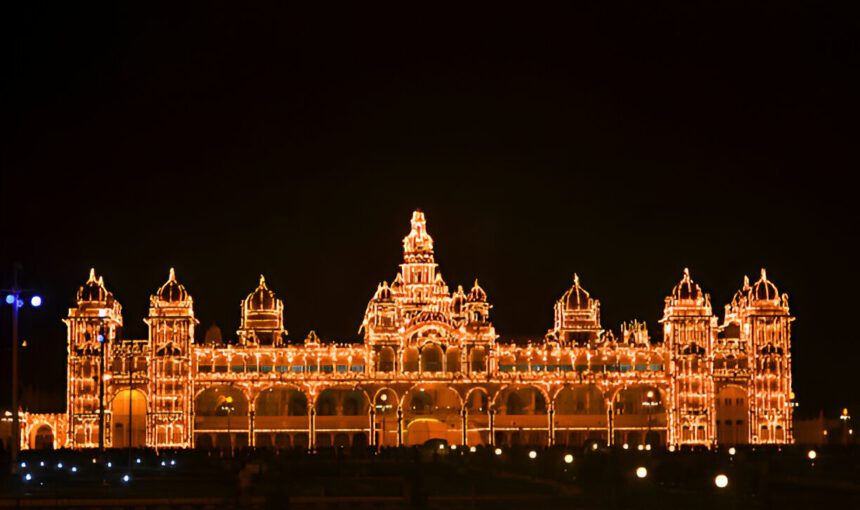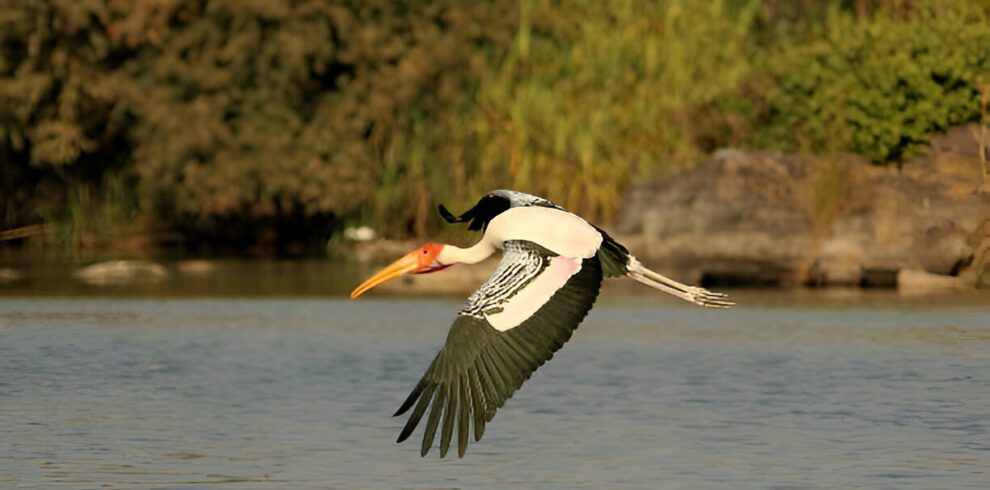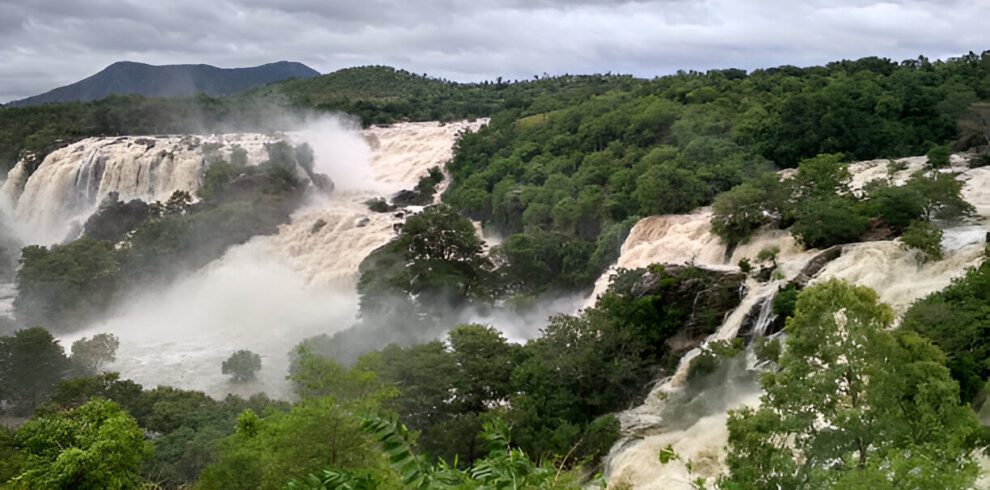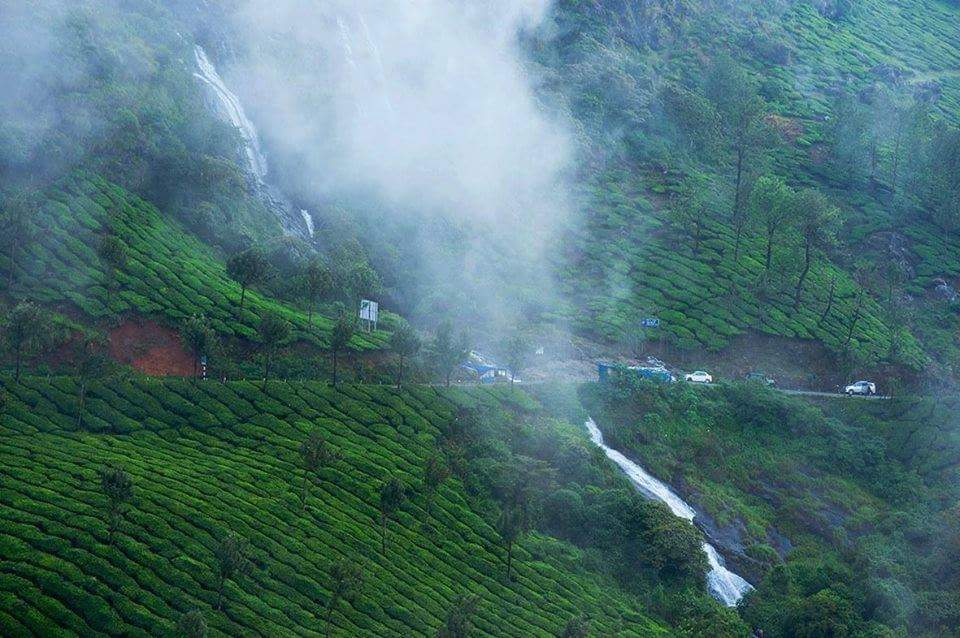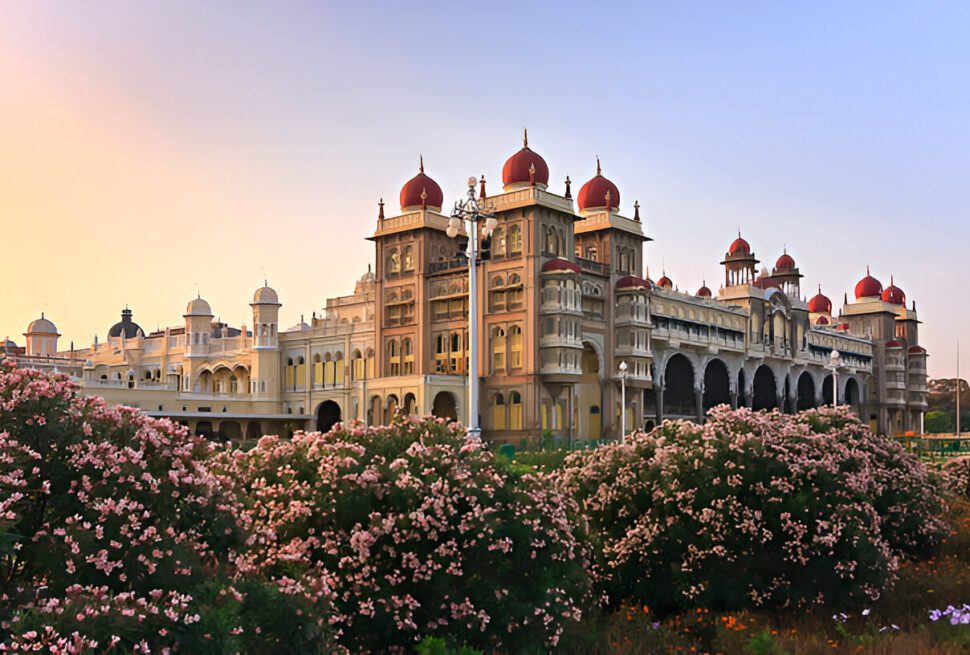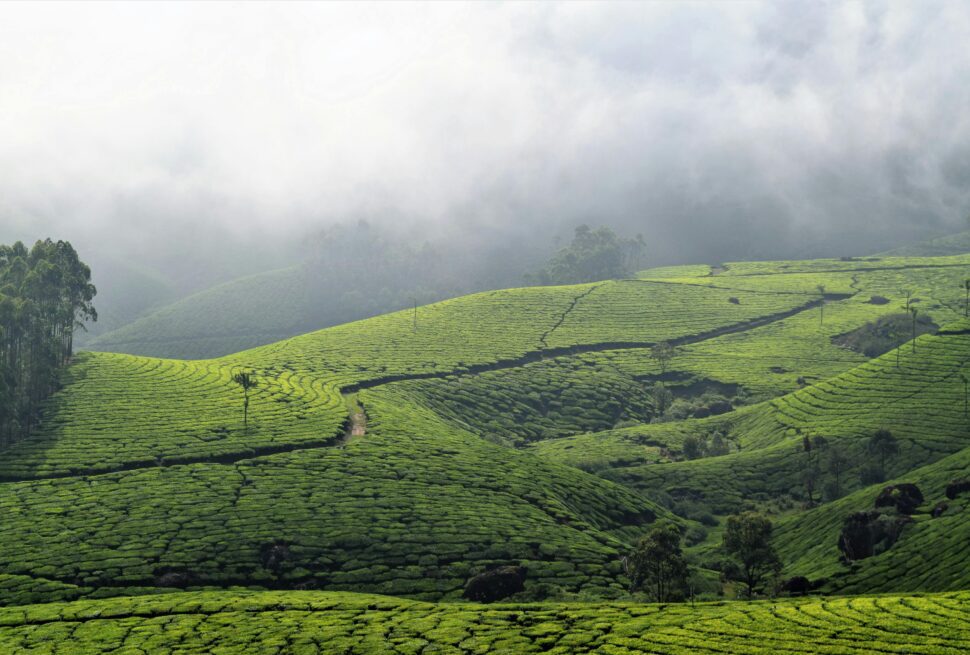When you think about the iconic landmarks of India, Mysore Palace is undoubtedly one that stands out. Whether a trip is taken to Mysore from Bangalore or elsewhere, this majestic structure should top the itinerary.
A visit to Mysore Palace feels like stepping back in time, where India’s royal opulence remains alive. The fascinating history of this royal residence should be explored to understand why it is among India’s most visited monuments.

Mysore Palace: A Glimpse into Royalty
The Grand History Behind the Palace
Mysore Palace, also known as Amba Vilas Palace, was once the royal residence of the Wadiyar dynasty. They ruled the Kingdom of Mysore for over 500 years. The original palace was built in the 14th century. But, it faced multiple destructions, including one major fire during a royal wedding in 1897.
The structure you see today was completed in 1912 and was designed by British architect Henry Irwin. This modern version of the palace beautifully blends Hindu, Islamic, Gothic, and Rajput architectural styles, creating a one-of-a-kind masterpiece.
Walking through the gates of the palace, you immediately feel the grandeur and royalty that surrounded the Wadiyar family. Imagine living in such an enormous, lavish home! With its 145-foot high towers, intricately carved wooden doors, and sprawling gardens, Mysore Palace truly is a wonder to behold. You’ll feel like you’ve been transported to an era where kings, queens, and princely courts held sway.
Click here to know more about Wadiyar Dynasty.
What to See Inside the Palace

The palace interiors are just as jaw-dropping as its exteriors. Upon stepping inside, visitors are greeted by a colorful and ornate Durbar Hall, where royal ceremonies were held. The hall is adorned with beautiful stained glass, mosaic tiles, and decorative pillars, all designed to impress. The royal family spared no expense in making every inch of this palace look magnificent.
As the palace is explored further, the Ambavilasa, a private audience hall, is encountered, one of the most decorated rooms. This was where the king held meetings with his ministers. The room features a door made of rosewood, inlaid with ivory, and the ceilings are embellished with intricate designs. It’s easy to get lost in the details here, with every corner revealing more beauty than the last.
One of the most fascinating areas of the palace is the Palace Gallery, which displays royal artifacts, paintings, and sculptures. The Palace Gallery is one of the most fascinating areas, showcasing a collection of royal artifacts, paintings, and sculptures. This gallery truly brings the rich history of the Wadiyar dynasty to life.
The Famous Mysore Dasara Celebrations
If you happen to plan your Mysore trip from Bangalore during October, you’re in for a treat. Mysore Dasara festival, a ten-day celebration of goddess Chamundeshwari’s victory over the demon Mahishasura, is held during this time. And guess where the main festivities happen? That’s right—Mysore Palace. During Dasara, the palace is illuminated with over 100,000 light bulbs, turning it into a glowing beacon.
The grand Jumbo Savari, or elephant procession, is the festival’s highlight, starting from the palace and winding through Mysore’s streets. This royal procession features decorated elephants, dancers, musicians, and royal family members, celebrating Mysore’s rich cultural heritage. During this time, the palace becomes the heart of the city’s festivities, and the experience is not to be missed.
The Palace Grounds and Gardens
After touring the palace interior, don’t forget to take a stroll through the palace grounds. The lush, well-maintained gardens that surround the palace are perfect for a leisurely walk. The palace grounds cover 72 acres, where families enjoy picnics and tourists capture the palace’s beauty from various angles.
The palace complex also includes a temple dedicated to the goddess Chamundeshwari, where you can witness local devotees offering prayers. The architecture of this temple complements the grandeur of the palace, making it a peaceful and spiritual spot to visit.
If you enjoy photography, the best time to capture the essence of Mysore Palace is at sunset. The golden hour light adds a magical glow, transforming the palace into a shimmering jewel in the city’s skyline.
How to Make the Most of Your Visit
To get the best experience from your Mysore trip, visits should be planned during weekdays to avoid weekend crowds. Guided tours are offered in multiple languages, providing a deeper understanding of the palace’s history and significance. Plenty of family-friendly activities and spaces are available around the palace, making it an ideal destination for all ages.
At least two to three hours should be allocated to explore the palace and its surrounding gardens fully. Once the layers of history, art, and culture inside Mysore Palace are discovered, more time will be wished for. The palace’s official timings should be checked before visiting, as they can vary depending on the season.
St. Philomena’s Church: A Deep Dive into the History of This Architectural Marvel
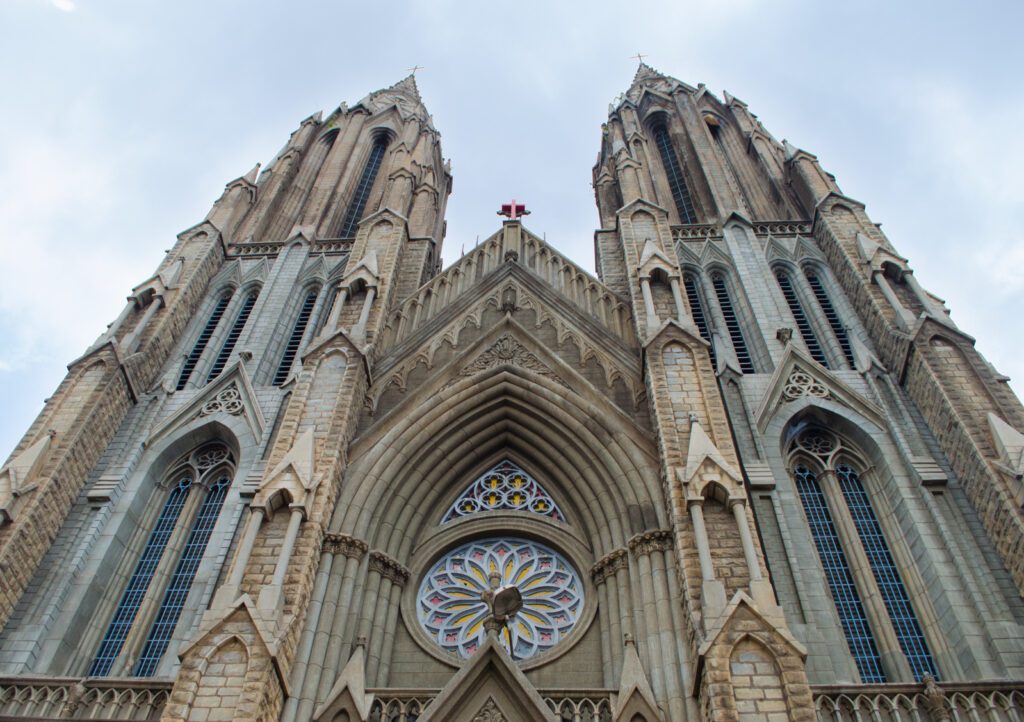
When you’re planning your Mysore trip from Bangalore, one of the must-visit spots is the breathtaking St. Philomena’s Church. This Gothic-style church is not only a major landmark in Mysore but also one of the largest churches in India. Whether you’re a history buff or simply someone who appreciates stunning architecture, St. Philomena’s Church offers an unforgettable experience. Let’s take a closer look at the history, significance, and the architectural beauty that makes this place so special.
The Origins of St. Philomena’s Church
St. Philomena’s Church has a rich history that dates back to the colonial era. Built in 1936, the church was commissioned by Maharaja Krishnaraja Wodeyar IV, the Mysore ruler at that time. A place of worship was desired by him for the growing Christian community in the city. The church is dedicated to St. Philomena, a young Christian martyr, and symbolizes unity and religious tolerance in Mysore.
The church is located on the site of a smaller church built by the French in the 1800s. However, a larger church was needed due to the increasing number of Christians in the city. The foundation stone for the current structure was laid by the Maharaja himself in 1933. What stands today is a towering Gothic cathedral, inspired by the Cologne Cathedral in Germany .
Architectural Grandeur and Inspiration
One of the first things noticed about St. Philomena’s Church is its striking Gothic architecture. With twin spires reaching 175 feet, this majestic structure cannot be missed during a Mysore trip from Bangalore. The church’s design was inspired by medieval European cathedrals, especially the famous Cologne Cathedral in Germany. The grandeur and beauty of this architectural marvel are contributed by the tall spires and intricate stained glass windows.
The twin spires symbolize spiritual aspiration and are visible from various parts of Mysore city, enhancing the church’s iconic status. Upon entering the church, visitors are greeted by an expansive nave that can hold up to 800 people. The ceilings and marble altar create a sense of space and grandeur, making it a serene place for prayer.
The most impressive feature of St. Philomena’s Church is the stained glass windows, which depict scenes from Christ’s life. These colorful windows represent exceptional craftsmanship and enhance the overall splendor of the church’s interiors. Hours can be spent admiring the intricate details found in every corner of the church.
The Spiritual Significance of St. Philomena
St. Philomena’s Church is not only a marvel of architecture but also holds deep spiritual significance. The church is named after St. Philomena, a young Greek princess martyred for her Christian faith in the 4th century. She was declared a saint after her relics were discovered in Rome’s catacombs in the early 19th century. She is regarded as a powerful intercessor for those in need.
In fact, a relic of St. Philomena is preserved in the underground catacomb beneath the church’s altar. Many pilgrims from across India and even abroad visit St. Philomena’s Church to seek her blessings. Whether you’re religious or not, it’s hard to miss the peaceful and spiritual atmosphere that envelops the church.
St. Philomena’s Church also plays a key role in the Christian community of Mysore. Daily masses are held here, and the church comes alive during major Christian festivals such as Christmas and Easter. If you happen to visit during these times, you’ll witness beautifully lit candles, choirs singing hymns, and a gathering of people celebrating their faith in this historic and sacred space.
Visiting St. Philomena’s Church During Your Mysore Trip
If you’re on a Mysore trip from Bangalore, a visit to St. Philomena’s Church is easy to plan and a great way to add variety to your itinerary. The church is centrally located in Mysore, making it accessible whether you’re driving or using public transport. Visiting the church is free, and it is open to visitors every day from early morning until evening.
The best time to visit is early in the morning when the church is less crowded, and you can enjoy the peaceful surroundings. Make sure to walk around the church grounds as well, where you can get a closer look at the exterior architecture and snap some great photos of the twin spires rising high against the Mysore skyline.
If you’re someone who enjoys history, architecture, or even just quiet, serene places, this church is a perfect stop. And while Mysore has its fair share of palaces and temples, St. Philomena’s Church offers a completely different kind of experience. It’s a refreshing change of pace and adds a layer of diversity to your Mysore itinerary.
If you want to learn more about Mysore Dasara: A Festival of Royalty, click here to learn more!
Somanathapura Temple: Exploring the Intricate Hoysala Architecture Nearby

When you’re planning your Mysore trip from Bangalore, there’s one architectural gem you simply can’t miss: the stunning Somanathapura Temple. Just a short drive from Mysore, this ancient temple is a masterpiece of Hoysala architecture, offering a unique blend of history, art, and culture. Whether you’re a history enthusiast or just love beautiful structures, Somanathapura Temple will leave you mesmerized with its intricate carvings and serene atmosphere.
A Hidden Gem of the Hoysala Dynasty
Nestled along the banks of the Cauvery River, Somanathapura Temple dates back to the 13th century and was built during the reign of the Hoysala Empire. The temple, dedicated to Lord Keshava, is a perfect example of Hoysala craftsmanship and architectural brilliance. Although the temple is no longer used for worship, it stands as a monument to the skill and devotion of its builders. Unlike many other temples in Karnataka, Somanathapura is less crowded, giving you plenty of space to explore and appreciate its beauty at your own pace.
As soon as you enter the temple complex, you’ll be greeted by its star-shaped platform, a hallmark of Hoysala architecture. Every inch of the temple is covered in intricate carvings, from the base to the tower, depicting mythological scenes, celestial beings, and detailed motifs. The symmetry and precision in these carvings are mind-blowing, and you can spend hours just admiring the craftsmanship. Even if you’re not a history buff, you’ll find yourself drawn into the stories etched into the temple’s stone walls.
Marvel at the Intricate Stone Carvings
One of the main attractions of Somanathapura Temple is its exquisitely detailed carvings. The outer walls are covered with intricate friezes, each telling stories from Hindu epics like the Ramayana and Mahabharata. These carvings are so finely detailed that you can see the individual expressions on the faces of the characters, despite the fact that they were created centuries ago.
Take your time as you walk around the temple. You’ll notice that no two carvings are exactly alike, showcasing the incredible skill of the artisans who created them. From beautifully adorned deities to animals like elephants and lions, the temple’s walls are like a stone canvas, capturing the essence of ancient Indian mythology and art. It’s amazing to think that these sculptures were made without any modern tools, and yet they remain so well-preserved.
Another highlight of the temple is the richly carved pillars that support the roof. Each pillar is a work of art in itself, with detailed patterns and figures that are unique to Hoysala architecture. These pillars also serve as a reminder of the incredible engineering and artistic capabilities of the time, as they’ve stood the test of centuries without losing their charm. The attention to detail in these stone structures will leave you awestruck.
A Peaceful Escape from the City
If you’re seeking a peaceful escape during your Mysore trip from Bangalore, Somanathapura Temple offers just that. The quiet, serene atmosphere of the temple grounds makes it an ideal spot to relax and soak in the beauty of your surroundings. Unlike the bustling city attractions, this off-the-beaten-path destination lets you experience a more tranquil side of Karnataka’s history. You can walk around at your own pace, taking in the calmness of the location while appreciating the temple’s artistry.
The temple is surrounded by lush greenery, adding to its peaceful charm. You can enjoy a leisurely stroll around the temple complex, or find a quiet spot to sit and reflect on the incredible history that surrounds you. Because it’s located outside of Mysore’s main tourist hotspots, you won’t have to deal with large crowds, making it a perfect spot for a quiet afternoon. It’s also a great spot for photography enthusiasts, as the light and shadows play beautifully on the temple’s stone walls, making for some stunning shots.
A Quick Stop on Your Mysore Itinerary
Adding a visit to Somanathapura Temple to your Mysore trip from Bangalore is a breeze, as it’s just about 35 kilometers from Mysore. You can easily make it a day trip or include it as part of a longer itinerary exploring the nearby historical sites. The road to Somanathapura is well-maintained, and the drive itself is a scenic one, taking you through peaceful villages and countryside.
It’s best to visit the temple early in the morning or late afternoon when the weather is cooler, and the lighting is perfect for appreciating the detailed carvings. The temple complex is open every day, making it convenient to fit into your travel schedule. Plus, the entrance fee is minimal, making it an affordable addition to your trip.
Whether you’re a history lover or simply looking for a peaceful escape from the city, Somanathapura Temple is a must-see. It adds a layer of depth to your Mysore trip from Bangalore, allowing you to explore not only the more famous attractions like Mysore Palace and Chamundi Hill, but also a hidden architectural gem that showcases the rich history of the Hoysala dynasty.
If you want to visit these places then do check our Mysore tour packages
Historical Srirangapatna: The Significance of Tipu Sultan’s Capital En Route
When you embark on your Mysore trip from Bangalore, you’ll pass through one of the most historically significant towns in Karnataka: Srirangapatna. This small town, located on an island in the Kaveri River, was once the mighty capital of Tipu Sultan, a figure who looms large in Indian history. As you drive through its charming streets, you’re stepping into a place that has witnessed fierce battles, colonial intrigue, and the rise and fall of empires. Srirangapatna is more than just a stop along the way – it’s a destination in itself, rich in stories waiting to be discovered.
The Legacy of Tipu Sultan
Srirangapatna is best known as the stronghold of Tipu Sultan, the legendary “Tiger of Mysore.” As you explore this historic town, you’ll feel the presence of this formidable ruler whose resistance against British colonization earned him a place in Indian history. The town served as Tipu’s capital and was the site of major battles between his forces and the British during the late 18th century.
One of the most prominent sites you can visit in Srirangapatna is Tipu Sultan’s Summer Palace, also known as the Daria Daulat Bagh. This beautiful palace, set amidst lush gardens, is a must-see for anyone interested in history. Built in 1784, it’s made entirely of teakwood and decorated with stunning frescoes and paintings that depict scenes from Tipu’s life and military campaigns. As you stroll through the halls, you can almost imagine Tipu himself planning his next move against the British forces.
Another important landmark is Tipu Sultan’s Mausoleum, or Gumbaz, which houses the tombs of Tipu, his father Sultan Hyder Ali, and his mother Fakhr-Un-Nisa. This beautifully crafted structure, with its Indo-Islamic architecture, is a serene spot to reflect on the life and times of one of India’s most iconic rulers. As you wander around the peaceful gardens surrounding the mausoleum, you’ll gain a deeper appreciation of the man whose legacy continues to shape the region.
A Walk Through Colonial History
In addition to being Tipu Sultan’s capital, Srirangapatna played a key role in the British conquest of southern India. The town was the site of the Fourth Anglo-Mysore War, where the British finally defeated Tipu Sultan in 1799. You can visit the Srirangapatna Fort, which was the epicenter of this conflict. The fort, with its thick walls and strategic location on the river island, provides a fascinating glimpse into the military architecture of the time. While much of the fort is in ruins today, several key sites within it are still intact and worth exploring.
One of the most notable spots inside the fort is the Water Gate, where Tipu Sultan was killed during the final battle with the British. A small plaque marks the spot, and standing there, you can feel the weight of history in the air. Another key attraction within the fort is the Ranganathaswamy Temple, a centuries-old temple dedicated to Lord Vishnu, which showcases the region’s rich religious and architectural heritage.
For those interested in military history, a visit to the Colonel Bailey’s Dungeon is a must. This underground prison was used by Tipu to imprison British officers during the war. It’s a stark, eerie place, with thick stone walls and a dark, damp atmosphere that gives you a sense of what life was like for those held captive here.
A Peaceful Riverside Town
Despite its turbulent history, Srirangapatna today is a peaceful riverside town that offers a tranquil contrast to the hustle and bustle of Mysore and Bangalore. One of the most enjoyable aspects of stopping in Srirangapatna during your Mysore trip from Bangalore is the opportunity to unwind and soak in the natural beauty of the region. The town is located on a scenic island in the Kaveri River, and there are several spots where you can relax by the water and enjoy a peaceful moment.
If you’re a nature lover, you’ll appreciate the Ranganathittu Bird Sanctuary, which is just a short distance from Srirangapatna. This sanctuary is home to a variety of migratory birds, and a boat ride along the river offers the perfect way to spot these feathered visitors. It’s a great way to break up your journey and enjoy the serene natural surroundings before heading back to the road.
Another must-visit spot is the Kaveri Riverbank, where you can enjoy a picnic or simply relax by the water’s edge. The riverbank is particularly beautiful in the early morning or late afternoon when the sun casts a golden glow over the landscape. It’s a peaceful escape from the town’s historical sites, giving you a chance to recharge before continuing your journey.
Why You Shouldn’t Miss Srirangapatna on Your Mysore Trip
Srirangapatna may not be as famous as Mysore, but it’s an essential part of any Mysore trip from Bangalore. The town’s historical significance, stunning architecture, and peaceful natural surroundings make it a perfect stop along the way. Whether you’re a history buff, a nature lover, or just someone looking for a quiet escape, Srirangapatna has something to offer.
From the legacy of Tipu Sultan to the scenic beauty of the Kaveri River, this charming town provides a unique glimpse into Karnataka’s rich past. So next time you’re planning a Mysore trip, make sure to carve out some time to explore Srirangapatna – you won’t be disappointed. Whether you spend a few hours here or decide to stay longer, the stories, sights, and experiences of this historic town are sure to leave a lasting impression.
